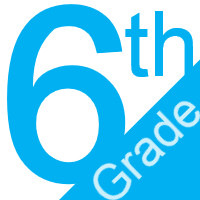6th Grade English
 Standards Glossaries
Standards Glossaries
| K Grade English | 1st Grade English | 2nd Grade English |
 Standards Glossaries
Standards Glossaries
| 3rd Grade English | 4th Grade English | 5th Grade English |
 Standards Glossaries
Standards Glossaries
| 6th Grade English | 7th Grade English | 8th Grade English |
 Standards Glossaries
Standards Glossaries
| 9th Grade English | 10th Grade English | 11th Grade English | 12th Grade English |
 Standards Glossaries
Standards Glossaries
| HS Journalism | HS Speech |
| All categories |
(W) WRITING |
|---|
ELA-06.W.07
Student Learning Targets:Knowledge Targets
Reasoning Targets
Skills (Performance) Targets
Product Targets
Proficiency Scale
ResourcesWebsiteswww.internet4classrooms (36) www.noodletools.com Vocabularyresearch support answer a question sources focused inquiry relevant sources (multiple print and digital) credibility paraphrase the data bibliography
| ||||||||||||||||||||||||||||||||||||||||||||
ELA-06.W.08
Student Learning Targets:Knowledge Targets
Reasoning Targets
Skills (Performance) Targets
Product Targets
Proficiency Scale
ResourcesWebsites Vocabulary | ||||||||||||||||||||||||||||||||||||||||||||
ELA-06.W.09
Student Learning Targets:Knowledge Targets
Reasoning Targets
Skills (Performance) Targets
Product Targets
Proficiency Scale
ResourcesWebsites Vocabulary | ||||||||||||||||||||||||||||||||||||||||||||
ELA-06.W.09a
Student Learning Targets:Knowledge Targets
Reasoning Targets
Skills (Performance) Targets
Product Targets
Proficiency Scale
ResourcesWebsites Vocabulary | ||||||||||||||||||||||||||||||||||||||||||||
ELA-06.W.09b
Student Learning Targets:Knowledge Targets
Reasoning Targets
Skills (Performance) Targets
Product Targets
Proficiency Scale
ResourcesWebsites Vocabulary | ||||||||||||||||||||||||||||||||||||||||||||
ELA-06.W.10
Student Learning Targets:Knowledge Targets
Reasoning Targets
Skills (Performance) Targets
Product Targets
Proficiency Scale
ResourcesWebsites Vocabulary | ||||||||||||||||||||||||||||||||||||||||||||
PRIORITIZED BENCHMARKS |
|---|
ELA-06.L
Narrative for (L) LanguageAs they move through formal schooling, students must continually learn how to gain control over the many conventions of Standard English grammar, usage, and mechanics. They must also learn to apply these language skills to their speaking and writing opportunities in order to help them convey meaning effectively and powerfully. Language standards include the rules of standard written and spoken English as well as the use of language as a craft with many choices. While some of the sub-standards under the language strand are grade-level specific, it is important to realize that certain expectations of language carry over from one grade to the next, 3-12. In order to see a clear picture of the progression of language standards, open the attached image above; there you will see that students never stop learning about the enduring standards of our language. English grammar, conventions, knowledge of language and vocabulary extend across reading, writing, speaking and listening and, in fact, are inseparable from these contexts. Calculation Method for StrandsStrands are larger groups of related standards. The Strand Grade is a calculation of all the related standards. Click on the standard name below each strand to access the learning targets and proficiency scales for each strand's related standards. | |
ELA-06.L.01
Student Learning Targets for 6th Grade English:Knowledge Targets
Reasoning Targets
Skills (Performance) Targets
| ||||||||||||||||||||||||||||||||||||||||
| Score | 6.L.01 Demonstrate command of the conventions of standard English grammar and usage when writing or speaking. | Sample Activity |
|
| 4.0 | In addition to Score 3.0, the student is able to demonstrate correct usage of pronouns independently and is able to identify pronoun type without prompting. | ||
| 3.5 | In addition to Score 3.0 performance, the student demonstrates in-depth inferences and applications regarding the more complex content with partial success. | ||
| 3.0 |
“The Standard.” The student:
The student exhibits no major errors or omissions. |
|
|
| 2.5 | The student demonstrates no major errors or omissions regarding the simpler details and processes (Score 2.0 content) and partial knowledge of the more complex ideas and processes (Score 3.0 content). | ||
| 2.0 |
There are no major errors or omissions regarding the simpler details and processes as the student:
However, the student exhibits major errors or omissions regarding the more complex ideas and processes. (For example on questions 5-7, if they recognize the correct pronoun but can not identify its type.) |
- | |
| 1.5 | The student demonstrates partial knowledge of the simpler details and processes (Score 2.0 content) but exhibits major errors or omissions regarding the more complex ideas and procedures (Score 3.0 content). | ||
| 1.0 | With help, the student demonstrates a partial understanding of some of the simpler details and processes (Score 2.0 content) and some of the more complex ideas and processes (Score 3.0 content). | ||
| 0.5 | With help, the student demonstrates a partial understanding of some of the simpler details and processes (Score 2.0 content) but not the more complex ideas and processes (Score 3.0 content). | ||
Resources:
Websites
www.funbrain.com
www.quizlet.com
easygrammar4kids/pronouns
Vocabulary
intensive pronouns
subjective pronouns
objective pronouns
possessive pronouns
reflexive pronouns
antecedent
indefinite pronouns
ELA-06.L.02
Student Learning TargetsKnowledge Targets
Reasoning Targets
Skills (Performance) Targets
Product Targets
Proficiency Scale:
Resources:WebsitesWhen searching for help, google "capitalization, spelling, and punctuation" Owl - a Little Help with Capitals Vocabulary
| ||||||||||||||||||||||||||||||||||||||||
ELA-06.L.04
Student Learning Targets for 6th Grade English:Knowledge Targets
Reasoning Targets
Skills (Performance) Targets
Product Targets
Proficiency Scale
ResourcesWebsiteswww.dictionary.com www.merriam-webster.com (vocabulary games and practices quizes) Vocabularysuffix root/base word prefix dictionary thesauruses glossaries
| ||||||||||||||||||||||||||||||||||||||||
ELA-06.L.05
Student Learning Targets: for Grade 6 English:Knowledge Targets
Reasoning Targets
Skills (Performance) Targets
Product Targets
Proficiency Scale
ResourcesWebsiteswww.funbrain.com www.globalclassroom.org google search "figurative language" Vocabularyalliteration idiom simile metaphor personification onomatopoeia hyperbole irony pun connotation denotation nuances word analogies
| ||||||||||||||||||||||||||||||||||||||||



